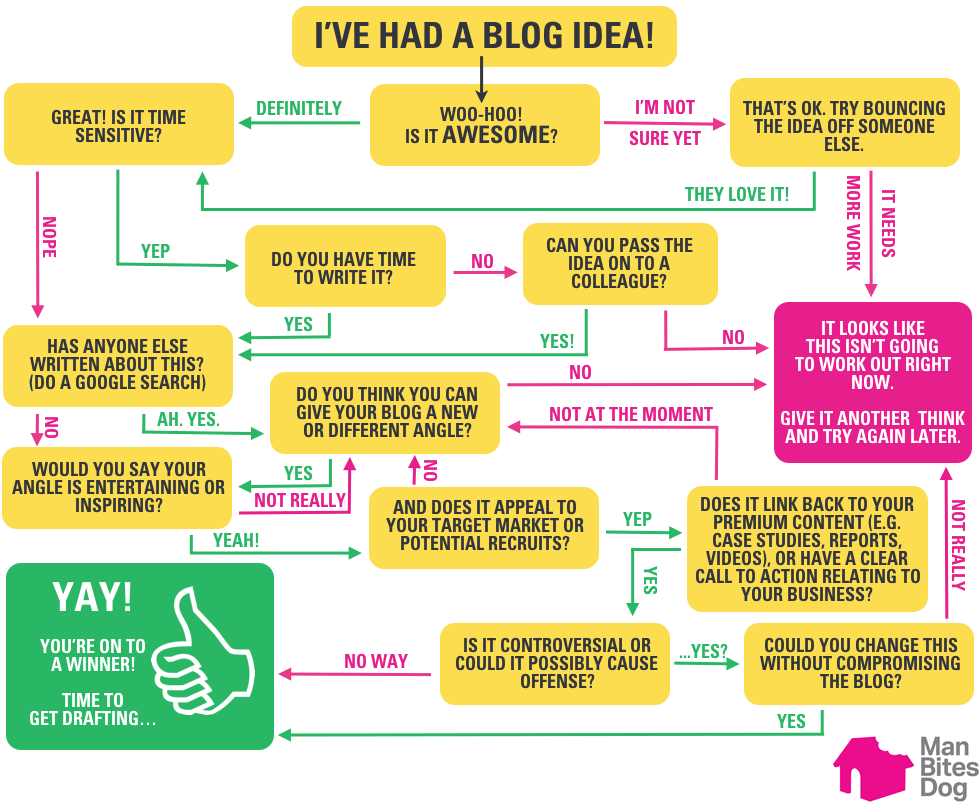You are the kind of person who works really hard and gets the job done. But between keeping your clients satisfied and staying on top of all of your other daily tasks, it often feels like there isn’t a lot of time to do much else. And then someone in your business asks you to write a blog…
You know that blogs are important because they fuel SEO to your website, give your company a voice, fuel your PR efforts and show off your expertise, but knowing where to start is another kettle of fish and time is precious. So, it’s important that you follow a process when writing blogs, not only to make the most of your time, but to get the most strategic value from your hard work.
Follow these four tips, and you’ll be a blogging hero in no time.
Someone may suggest a topic to you, or perhaps you’ve already had an idea, but before you get drafting, be sure to run it through our handy blog topic flow-chart below to see if it fits the criteria of a good corporate blog. This includes not being contentious or offensive, linking back to your premium content or core proposition and of course being original.

If your idea meets these criteria (go you!), skip right ahead to point two.
If not, or if you’re starting from scratch and looking for an idea, here are a few places where inspiration might strike:
If none of these spark ideas, you could try entering a keyword that is relevant to your business into this blog title generator and seeing what comes up: https://www.portent.com/tools/title-maker
And if you’re looking for a topical hook, Google Trends is a great place to start.
Just be sure to run the idea through the flow-chart before you get started to see if it’s viable.
Structure: Before you start drafting, have you thought about the structure of your blog? A great structure to follow is the SCQA model; situation, complication, question, answer. At the very least, ensure your blog has a strong beginning, middle and end with a conclusion that includes a strong call to action.
And if your blog topic is quite complicated, you could try the US Army communications model: "Tell them what you're going to tell them, tell them, and then tell them what you told them."
Remember, very few writers will strike on a fantastic piece of content in their first draft. As Stephen King says, “Write with the door closed, edit with the door open” – in other words, exorcise your ideas in an expansive brain dump before you start refining and polishing.
Tone: Write personally, with a distinctive tone of voice, as people will care more about what they’re reading if you do. Be bold. Share your knowledge. Show off your expertise. But don’t waffle! Verbosity is a massive turn-off for readers. Check your blog with the Unsuck It App to remove jargon and the Hemingway App to make sure you’re getting to the point! Don’t get too hung up on crafting a piece of art, just make sure your message is right.
Titles: ‘5 Ways to…’ and ‘Why X should do Y’ type blogs perform particularly well (again, if you’re stuck the Title Maker tool can be helpful). If you’re doing a ‘10 top tips’ style piece, try to avoid multiples of five or ten as people tend to assume there are filler points if it’s a round number! Your title needs to explain the story (unlike with print where the page informs the reader whether to read) and draw the reader in. Using song titles, movie names or popular phrases is good, but ensure that it relates to your content.
Once you’ve run through the flow-chart, drafted your blog and edited it, it’s important to ask someone else to proof-read it. This doesn’t necessarily need to be a colleague, but it is useful to run it past someone familiar with the subject matter to sense check your argument. A second pair of eyes can also be useful as we tend to miss our own mistakes when it comes to spelling and grammar, and these kind of typos can be very off-putting to readers.
When you’re happy that your blog is as polished as it can be, reads well and is free from typos, post it!
Once your blog is posted, don’t forget to share it via your social media channels and ask your colleagues to do the same to really get the most out of your content.
Happy blogging!
Head Office
Moore House
13 Black Lion Street
Brighton
United Kingdom
BN1 1ND
London Office
24/25 The Shard
32 London Bridge Street
London
United Kingdom
SE1 9SG
+44 (0) 1273 716 820
[email protected]
Head Office
Moore House
13 Black Lion Street
Brighton
United Kingdom
BN1 1ND
London Office
24/25 The Shard
32 London Bridge Street
London
United Kingdom
SE1 9SG
© 2005 - 2024 Man Bites Dog